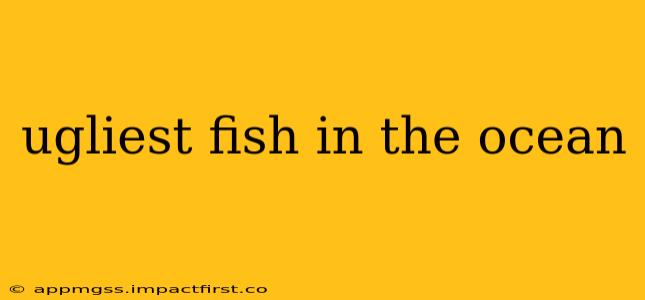The title "ugliest fish in the ocean" is, of course, subjective. Beauty is in the eye of the beholder, and what one person finds repulsive, another might find fascinating. However, certain fish consistently top the lists of contenders for this dubious honor, largely due to their unusual features and adaptations. This isn't about judging these creatures; it's about exploring the fascinating diversity of life in our oceans and appreciating the unique adaptations that make them so…well, unique.
What Makes a Fish "Ugly"?
Before we dive into the contenders, let's define our terms. What constitutes "ugly" in the context of fish? Common factors include:
- Unusual coloration: Lack of vibrant colors, blotchy patterns, or dull hues can contribute to a perception of ugliness.
- Unconventional body shape: Protruding eyes, oddly shaped mouths, or unusual fins can make a fish appear less aesthetically pleasing to the human eye.
- Strange textures: Rough skin, fleshy growths, or other unusual textures can add to the perceived "ugliness."
It's important to remember that these characteristics are often functional adaptations, perfectly suited to the fish's environment and survival needs.
The Contenders for the Title of "Ugliest Fish"
Several species frequently appear on "ugliest fish" lists. Let's examine some of the most prominent contenders:
The Blobfish (Psychrolutes microporos)
Often cited as the ugliest fish in the ocean, the blobfish's gelatinous, shapeless form is certainly unconventional. Its appearance is largely due to its deep-sea habitat, where the immense pressure minimizes the need for a strong, structured body. On land, it loses its firmness and takes on the saggy appearance that has earned it its fame (or infamy). However, in its natural environment, it is likely much more streamlined.
The Pacific Footballfish (Himantolophus sagamius)
With its bioluminescent lure and grotesque appearance, the Pacific footballfish is a strong contender for the title. This deep-sea anglerfish sports a large, flat head, a gaping mouth, and a fleshy appendage that dangles to attract prey. Its overall appearance is certainly striking, and some would say, ugly. But remember, its features are crucial for survival in the dark depths of the ocean.
The Goblin Shark (Mitsukurina owstoni)
The Goblin Shark, with its elongated snout and protruding jaws, is another unusual-looking creature. Its pink skin and unique jaw structure, which can extend outwards to capture prey, contribute to its somewhat unsettling appearance. However, its distinct features are perfectly adapted to its deep-sea hunting strategy.
The Wolf Eel (Anarrhichthys ocellatus)
While not as immediately striking as some other contenders, the Wolf Eel's large, powerful jaws and somewhat menacing appearance earn it a place in the conversation. Its elongated body and sharp teeth contribute to its formidable appearance. However, it is primarily a bottom-dwelling fish that uses its powerful jaw to crush shellfish, rather than an aggressive predator.
Why Do We Find Certain Fish "Ugly"?
Our perception of what constitutes "ugliness" is heavily influenced by our own anthropocentric biases. We tend to find features that deviate from our own aesthetic preferences less appealing. It's important to remember that the "ugliest" fish are often perfectly adapted to their unique environments and play vital roles in their ecosystems.
H2: Are There Other Fish Considered Ugly?
Yes, many other fish possess features that some might consider "ugly." This often depends on personal preferences and familiarity. Many deep-sea creatures, with their unusual adaptations to extreme environments, often fit this description.
H2: Why are Deep Sea Fish so "Ugly"?
Deep-sea fish often lack the vibrant colors and streamlined bodies of their shallow-water counterparts. This is because their environment doesn't require the same visual displays or agility. The pressure, lack of light, and unique food sources select for adaptations that may appear unusual or "ugly" to human observers.
Conclusion: Embracing the Unique Beauty of Ocean Life
While the title of "ugliest fish in the ocean" is subjective and largely based on human aesthetic preferences, these creatures demonstrate remarkable adaptations to their environments. Rather than focusing on their perceived ugliness, we should appreciate the diversity and resilience of life in our oceans, celebrating the unique features that allow each species to thrive. Ultimately, the "ugliness" of these fish only enhances their remarkable story of adaptation and survival.
